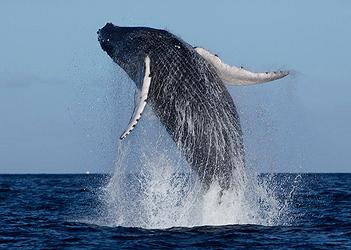
HONOLULU, Hawaii, September 20, 2015 (ENS) – The U.S. Navy has agreed to limit its use of sonar and explosives training that harms whales, dolphins and other marine mammals off Hawaii and California in a settlement with environmental groups.
Signed by a federal judge in Honolulu, the combined settlement of two cases orders limits or bans on mid-frequency active sonar and explosives in areas of vital habitat around the Hawaiian Islands and Southern California, said Earthjustice attorney David Henkin.

“If a whale or dolphin can’t hear, it can’t survive,” said David Henkin, an attorney for the national legal organization Earthjustice, who brought the initial challenge to the Navy’s latest round of training and testing on behalf of Conservation Council for Hawaii, the Animal Welfare Institute, the Center for Biological Diversity, and the Ocean Mammal Institute.
“We challenged the Navy’s plan because it would have unnecessarily harmed whales, dolphins, and endangered marine mammals, with the Navy itself estimating that more than 2,000 animals would be killed or permanently injured,” said Henkin.
“By agreeing to this settlement, the Navy acknowledges that it doesn’t need to train in every square inch of the ocean and that it can take reasonable steps to reduce the deadly toll of its activities,” he said.
The Navy’s plans estimate the training and testing could kill 155 whales and dolphins off Hawaii and Southern California, mostly from explosives. The Navy estimated it could cause more than 11,000 serious injuries off the East Coast and 2,000 off Hawaii and Southern California.
Yet, until now the Navy has refused to set aside biologically important areas to minimize such harm to vulnerable marine mammal populations.
Until it expires in late 2018, the agreement will protect habitat for the most vulnerable marine mammal populations, including endangered blue whales for which waters off Southern California are a globally important feeding area.
Still, the Navy will continue some of the training. Lt. Cmdr. Matt Knight, a U.S. Pacific Fleet spokesman, said the settlement preserves key testing and training.
“Recognizing our environmental responsibilities, the Navy has been, and will continue to be, good environmental stewards as we prepare for and conduct missions in support of our national security,” Knight told the “Stars and Stripes” newspaper.

Under the agreement, the Navy cannot use sonar in Southern California habitat for beaked whales between Santa Catalina Island and San Nicolas Island. Sonar is not allowed in blue whale feeding areas near San Diego.
In Hawaii, the settlement prohibits sonar and explosives training on the eastern side of the Big Island of Hawaii and north of the islands of Molokai and Maui.
The groups said that will protect endangered Hawaiian monk seals and small populations of toothed whales, for which the islands are literally an oasis, their only home.
“Some of the marine mammals threatened by Navy activities are already on the brink of extinction, such as the Hawaiian monk seal, our state mammal and one of the world’s most endangered species,” said Conservation Council for Hawaii’s Marjorie Ziegler. “This settlement helps protect marine habitat the Fisheries Service just last month identified as essential to the seal’s survival.”
The Navy will not be able to exceed a set number of major training exercises in the channel between Maui and the Big Island and on the western side of the Big Island.
“We can protect our fleet and safeguard our whales,” said Rhea Suh, president of the Natural Resources Defense Council, whose lawyers challenged the Navy’s activities in Southern California and Hawaii on behalf of NRDC, Cetacean Society International, Animal Legal Defense Fund, Pacific Environment and Resources Center, and Michael Stocker.
“This settlement shows the way to do both, ensuring the security of U.S. Navy operations while reducing the mortal hazard to some of the most majestic creatures on Earth,” said Suh. “Our Navy will be the better for this, and so will the oceans our sailors defend.”
“This settlement proves what we’ve been saying all along,” said Marsha Green, president of Ocean Mammal Institute. “The Navy can meet its training and testing needs and, at the same time, provide significant protections to whales and dolphins by limiting the use of sonar and explosives in vital habitat.”
Copyright Environment News Service (ENS) 2015. All rights reserved.
© 2015, Environment News Service. All rights reserved. Content may be quoted only with proper attribution and a direct link to the original article. Full reproduction is prohibited.
